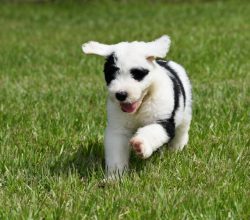
My Love for the Old English
My grandmother had an Old English Sheepdog named Barney . We were not allowed to have a dog where I lived and I would go visit her in the summertime and that was my favorite memory growing up . I always promised myself when I got older I would get a Old English Sheepdog .
I would always have one to remind me of her. For the last 20 years I have owned old English sheepdog‘s . My first old English sheep dog that I got I named him Barney . He was a spectacular creature. He was a Gentle giant .He was 120 pounds and a big fluff ball of love . He stayed with me for 13 years and I’ve kept a promise to myself to always keep a Old English Sheepdog .
AKC Herding Group
History
The Old English Sheepdog might have been created through crosses between Bearded Collies and animals brought to England from Russia, the Baltics, or France. In England, he was used primarily to drive sheep and cattle to the marketplace. Sometimes called “Bobtail,” the Old English Sheepdog’s tail was customarily docked in the eighteenth century as a way of identifying tax-exempt herding dogs. Farmers sheared their dogs each spring when they sheared their sheep, and then used the dogs’ hair to make warm blankets and clothing. The Old English Sheepdog is a fine sheep herding dog, but he also has been used for reindeer herding (because he tolerates cold weather so well), retrieving, and guarding. The Old English Sheepdog makes a fine family companion because he loves children.
Description
The Old English Sheepdog is a large, squarely proportioned, agile dog with a profuse shaggy coat. The body is stocky, well balanced, and muscular. The topline slopes upward from the withers to the loin. (This unusual topline is an important breed characteristic.) The brisket is very deep and the chest broad. The forelegs are straight with small, round feet pointing directly forward. The large, rather square head is covered with hair and has a well-defined stop. The small ears lie flat. The dog may have blue or brown eyes, or one of each color. The nose is large and black. The teeth should meet in a level or tight scissors bite. This breed is either born tailless or the tail is completely docked. The Old English Sheepdog has a long double coat with coarse guard hairs and a soft downy undercoat that insulates the dog. The accepted coat colors are blue, gray, blue gray, or blue merle, often with white markings. Sometimes white is the predominant color with markings of the above-listed darker colors. This breed has a rolling, bear-like gait.
Key Facts
- Height: Over 22 in. (male); over 21 in. (female)
- Size: Large
- Weight: Averages 80 lbs. (male); 65 lbs. (female)
- Availability: Might take some effort to find
- Talents: Retrieving, herding, and watchdog
Notes
Avoid puppy-mill dogs of this breed, as unscrupulous breeders have been deteriorating the breed’s temperament. Be sure to buy from a reputable source who is willing to work with the new owner if needed. When kept in full coat, the Old English Sheepdog needs extensive grooming to keep the coat from matting. However, if the dog is not being shown, he can be shaved to a “fun cut” (about 1 in. all the way around). The Old English Sheepdog has a resonant bell-like bark. Don’t overfeed. Prone to hip dysplasia and cataracts; buy only from stock with OFA, PennHIP, or another national hip-dysplasia clearance and current CERF or OFA eye clearance. The Old English Sheepdog remains young and active for many years.
Personality
A gentle, loving, and lovable teddy bear. Even tempered and adaptable. Friendly, intelligent, faithful, and protective. Has a strong herding instinct and might try to herd the family, especially small children. Herds by bumping, not nipping. Likes to stick close to home; makes a good couch potato. Can be strong willed, so the Old English Sheepdog needs firm training. Old English Sheepdogs are very good at herding and taking instructions, but tend to anticipate commands or do it their own way if they think their way is better. Motivational methods work best.
Behavior
- Children: Excellent with children
- Friendliness: Fairly friendly with strangers
- Trainability: Somewhat difficult to train
- Independence: Not particularly dependent or independent
- Dominance: Low
- Other Pets: Generally good with other pets
- Combativeness: Friendly with other dogs
- Noise: Average barker
- Indoors: Fairly active indoors
- Owner: Not recommended for novice owners
Care
- Grooming: Daily grooming is best
- Trimming and Stripping: Moderate trimming or stripping needed
- Coat: Medium long coat
- Shedding: Average shedder
- Docking: The tail is customarily docked
- Exercise: Moderate exercise needed
- Jogging: A fair jogging companion
- Apartments: Will be OK in an apartment if sufficiently exercised
- Outdoor Space: Best with at least an average-size yard
- Climate: Does well in most climates
- Longevity: Average (10 to 12 years)
Useful Links
AKC® Old English Sheepdog Breed Standard
http://images.akc.org/pdf/breeds/standards/OldEnglishSheepdog.pdf












